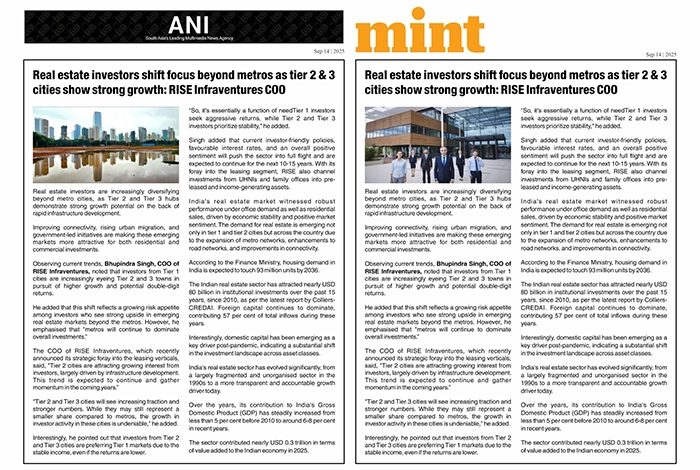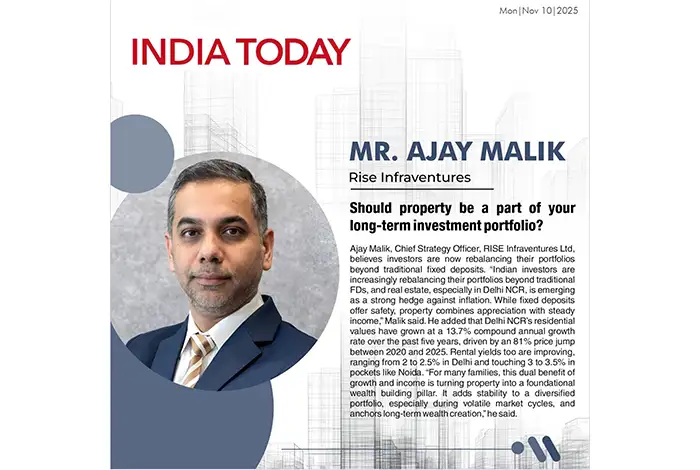Real Estate Investors Look Beyond Metros as Tier 2 & 3 Cities Gain Momentum: RISE Infraventures COO

Published by Media Infoline / Realty+
Real estate investors in India are increasingly looking beyond traditional metro cities as Tier 2 and Tier 3 towns show strong growth potential. Rapid infrastructure development, better connectivity, and government-led initiatives are making these emerging markets attractive for both residential and commercial investments.
Bhupindra Singh, Chief Operating Officer of RISE Infraventures, noted that investors from Tier 1 cities are now exploring Tier 2 and 3 towns, seeking higher growth and potential double-digit returns. "There is a clear shift in focus among investors from metro areas. They are looking at emerging cities as an opportunity to maximize returns while diversifying risk," he said.
Singh emphasized that while metros will continue to dominate overall investment activity, the interest in smaller cities is undeniable. Tier 2 cities, in particular, are drawing attention due to the rapid pace of infrastructure projects such as improved road networks, metro expansions, and enhanced connectivity to major hubs. This trend is expected to gain momentum over the next few years.
Investors from Tier 2 and 3 cities, however, often prefer Tier 1 markets. According to Singh, this reflects a difference in priorities: "Tier 1 investors are seeking aggressive growth and higher returns, while investors from smaller towns prioritize stability and predictable income." This dynamic is creating a balanced flow of investments across markets of varying sizes.
RISE Infraventures, which recently expanded into the leasing segment, is facilitating investments from ultra-high-net-worth individuals (UHNI) and family offices into pre-leased and income-generating assets. Singh explained, “The leasing segment offers a way for investors to secure steady returns while participating in the growth of emerging markets.â€
India's real estate market has shown robust performance in both residential sales and office demand. Economic stability, positive market sentiment, and infrastructure upgrades are driving demand not just in metros but also in Tier 2 and Tier 3 cities. According to the Finance Ministry, housing demand in India is expected to reach 93 million units by 2036, reflecting the growing need for both urban and semi-urban residential spaces.
Institutional investment in India's real estate sector has been strong. Since 2010, the industry has attracted nearly USD 80 billion, with foreign investors contributing 57% of the total inflows. Post-pandemic, domestic capital is emerging as a key driver, indicating a significant shift in the investment landscape across asset classes.
The sector has also evolved significantly over the past decades. From a fragmented and largely unorganized market in the 1990s, Indian real estate has become more transparent, accountable, and efficient. Its contribution to India's GDP has increased steadily, from less than 5% before 2010 to around 6–8% in recent years, with an estimated value addition of USD 0.3 trillion in 2025.
Singh believes that current investor-friendly policies, favorable interest rates, and overall positive sentiment will continue to support the sector's growth for the next 10–15 years. He added, "With strategic planning and careful execution, Tier 2 and Tier 3 cities will increasingly attract investor interest, and this trend is likely to reshape India's real estate landscape."
In conclusion, the Indian real estate sector is moving beyond metro cities, driven by infrastructure, urban migration, and strategic investor interest. With emerging markets gaining momentum, both residential and commercial segments offer strong opportunities for growth. Companies like RISE Infraventures are well-positioned to guide investors through this evolving landscape, making smaller cities an important part of India's real estate story.
Frequently Asked Questions
1. Why are investors looking beyond metro cities in India?
Investors are exploring Tier 2 and Tier 3 cities due to rapid infrastructure development, improved connectivity, and higher growth potential compared to traditional metros.
2. What drives growth in Tier 2 and Tier 3 cities?
Urban migration, government initiatives, better roads and metro networks, and growing commercial and residential demand are making these cities attractive for real estate investment.
3. How do investment priorities differ between Tier 1 and smaller city investors?
Tier 1 investors focus on higher returns and aggressive growth, while investors from Tier 2 and 3 cities prioritize stability and predictable income.
4. How is RISE Infraventures involved in these emerging markets?
RISE Infraventures is facilitating investments, including in leasing and pre-leased assets, helping investors capitalize on growth opportunities in Tier 2 and 3 cities.
5. What is the future outlook for India's real estate sector?
With favorable policies, positive market sentiment, and increasing domestic and foreign investment, India's real estate market is expected to grow steadily over the next 10–15 years.





